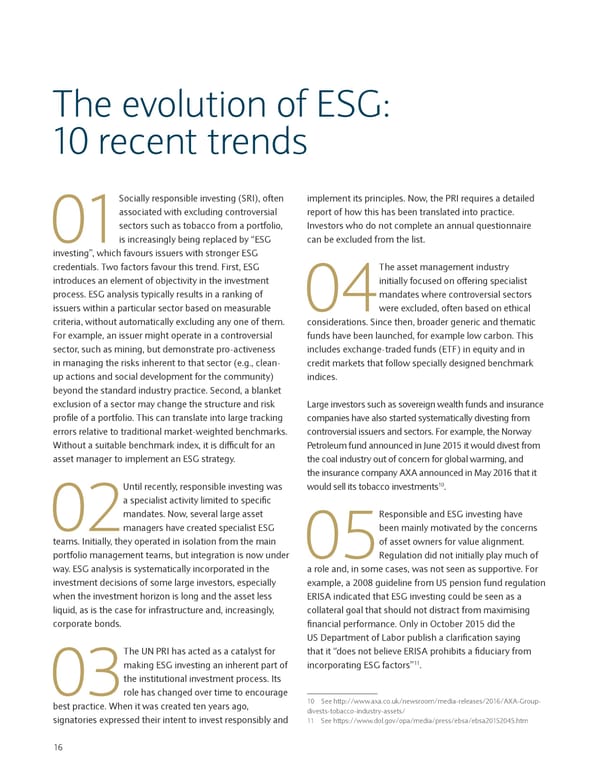The evolution of ESG: 10 recent trends Socially responsible investing (SRI), often implement its principles. Now, the PRI requires a detailed associated with excluding controversial report of how this has been translated into practice. sectors such as tobacco from a portfolio, Investors who do not complete an annual questionnaire 01 is increasingly being replaced by “ESG can be excluded from the list. investing”, which favours issuers with stronger ESG credentials. Two factors favour this trend. First, ESG The asset management industry introduces an element of objectivity in the investment initially focused on offering specialist process. ESG analysis typically results in a ranking of mandates where controversial sectors issuers within a particular sector based on measurable 04were excluded, often based on ethical criteria, without automatically excluding any one of them. considerations. Since then, broader generic and thematic For example, an issuer might operate in a controversial funds have been launched, for example low carbon. This sector, such as mining, but demonstrate pro-activeness includes exchange-traded funds (ETF) in equity and in in managing the risks inherent to that sector (e.g., clean- credit markets that follow specially designed benchmark up actions and social development for the community) indices. beyond the standard industry practice. Second, a blanket exclusion of a sector may change the structure and risk Large investors such as sovereign wealth funds and insurance profile of a portfolio. This can translate into large tracking companies have also started systematically divesting from errors relative to traditional market-weighted benchmarks. controversial issuers and sectors. For example, the Norway Without a suitable benchmark index, it is difficult for an Petroleum fund announced in June 2015 it would divest from asset manager to implement an ESG strategy. the coal industry out of concern for global warming, and the insurance company AXA announced in May 2016 that it Until recently, responsible investing was 10. would sell its tobacco investments a specialist activity limited to specific 02mandates. Now, several large asset Responsible and ESG investing have managers have created specialist ESG been mainly motivated by the concerns teams. Initially, they operated in isolation from the main of asset owners for value alignment. portfolio management teams, but integration is now under 05Regulation did not initially play much of way. ESG analysis is systematically incorporated in the a role and, in some cases, was not seen as supportive. For investment decisions of some large investors, especially example, a 2008 guideline from US pension fund regulation when the investment horizon is long and the asset less ERISA indicated that ESG investing could be seen as a liquid, as is the case for infrastructure and, increasingly, collateral goal that should not distract from maximising corporate bonds. financial performance. Only in October 2015 did the US Department of Labor publish a clarification saying The UN PRI has acted as a catalyst for that it “does not believe ERISA prohibits a fiduciary from making ESG investing an inherent part of 11. incorporating ESG factors” 03the institutional investment process. Its role has changed over time to encourage best practice. When it was created ten years ago, 10 See http://www.axa.co.uk/newsroom/media-releases/2016/AXA-Group- divests-tobacco-industry-assets/ signatories expressed their intent to invest responsibly and 11 See https://www.dol.gov/opa/media/press/ebsa/ebsa20152045.htm 16
 Sustainable Investing and Bond Returns Page 17 Page 19
Sustainable Investing and Bond Returns Page 17 Page 19